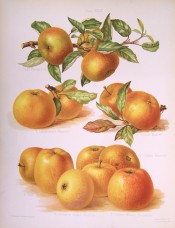Malus domestica ‘Golden Russet’
‘Fruit below the middle size, pretty regular in its outline, without angles, generally about two inches deep, and two inches and a quarter in diameter. Eye rather small, close, moderately depressed, surrounded by irregular plaits, part of which are more prominent than the rest. Stalk very short, deeply inserted in an uneven narrow cavity, not protruding so far as the base. Skin thick, of a pale copper-coloured yellowish russet, very thick and rough on the shaded side, with a few patches, occasionally, of bright red on the sunny side, and verrucose at the base. Flesh pale yellow, very firm and crisp. Juice not plentiful, but saccharine, of an aromatic and slightly musky flavour. A dessert apple from December till April.’ [George Lindley – Orchard Guide p.89/1831].
Horticultural & Botanical History
‘The tree is healthy and an excellent bearer, but requires a warm situation to bring the fruit to perfection. This is another of our old English apples. Worlidge calls it the Aromatick, or Golden Russeting, “it hath no compear, it being of a gold-color coat, under a russet hair, with some warts on it. It lives over the winter, and is, without dispute, the most pleasant apple that grows; having a most delicate aromatick hautgust, and melting in the mouth.” [Hogg p.99/1851].
History at Camden Park
Listed as ‘Golden Russet, apple no.60’ in a hand written list of apples in an 1850 catalogue held at Camden Park [CPA]. Most of the plants hand-written in this catalogue subsequently appeared in the 1857 catalogue. That the apples did not is probably an oversight.
Notes
Published Apr 17, 2010 - 03:46 PM | Last updated Jul 24, 2011 - 03:52 PM
| Family | Rosaceae |
|---|---|
| Category | |
| Region of origin | Garden origin, England |
| Synonyms |
|
| Common Name | Apple, Dessert apple, Keeping apple |
| Name in the Camden Park Record |
Golden Russet
|
| Confidence level | high |
